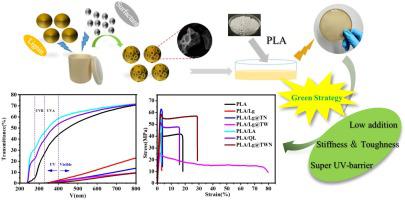Journal of Materials Processing Technology ( IF 6.7 ) Pub Date : 2021-01-26 , DOI: 10.1016/j.jmatprotec.2021.117052 Yangze Huang , Chenyang Cai , Zechang Wei , Pei Wang , Leixin Deng , Yongqin Wang , Yu Fu

|
The major obstacles to expand the applications of biodegradable poly(lactic acid) (PLA) are the poor toughness and the lack of UV protection in many fields, such as food and goods packaging. In this work, a bio-based “rigid-to-stretchable” conversion approach was presented for the first time to construct the plasticized lignin-based complex through mechanochemistry for the simultaneous improvement of toughness and strength on PLA matrix. With the aid of polymer-based surfactants as an interfacial modifier, the rigid lignin particles were significantly softened through a facile and green ball-milling process to form the plasticized complex with hetero-profiles. Apart from the conventional approach to the rubber-like toughener, the morphology-structured lignin-based complex was controllably regulated as the rigidity-sourced plasticizer to address the recalcitrant issues of interfacial compatibility and dispersion. With the strong and tough PLA-based composite films (PLA/Lg@TWN) successfully prepared, the tensile strength and the ultimate elongation simultaneously increases to 58.2 MPa and 32.5 % compared to those of the neat PLA of 15.8 MPa and 15.7 % respectively. The toughness was also enhanced from 7.21 MJ/m3 for pure PLA to 15.57 MJ/m3 for PLA/Lg@TWN. The specialized assembly of bio-derived aromatic structures was conducive to exploring ultraviolet resistance, exhibiting superb UV absorption property in UV A (100 %) and UV
A (100 %) and UV B (99.5 %) range compared to low UV absorption of UV
B (99.5 %) range compared to low UV absorption of UV A (57 %) and UV
A (57 %) and UV B (75 %) for neat PLA. Therefore, the developed multifunctional PLA films would present the promising potential for applications in the fields of packaging and agricultural materials with favorable mechanical properties and UV protection performance.
B (75 %) for neat PLA. Therefore, the developed multifunctional PLA films would present the promising potential for applications in the fields of packaging and agricultural materials with favorable mechanical properties and UV protection performance.
中文翻译:

生物基“刚性到可拉伸”转化为具有紫外线防护性能的强韧聚乳酸
扩大可生物降解的聚乳酸(PLA)应用的主要障碍是韧性差,在食品和商品包装等许多领域缺乏紫外线防护。在这项工作中,首次提出了一种基于生物的“从刚性到可拉伸”的转化方法,以通过机械化学方法构建增塑的木质素基复合物,以同时提高PLA基质的韧性和强度。借助于基于聚合物的表面活性剂作为界面改性剂,刚性木质素颗粒通过便捷的绿色球磨工艺显着软化,从而形成具有异型轮廓的增塑复合物。除了传统的类似橡胶增韧剂的方法外,形态结构的木质素基复合物被可控地调节为刚性来源的增塑剂,以解决界面相容性和分散性的顽强问题。成功地制备了坚固的PLA复合膜(PLA / Lg @ TWN),与纯PLA的15.8 MPa和15.7%相比,抗张强度和极限伸长率同时增加到58.2 MPa和32.5%。韧性也从7.21 MJ / m增强纯PLA为3到15.57 MJ / m 3 PLA / Lg @ TWN为3。生物衍生的芳族结构的专门组装有利于探索抗紫外线性,与之相比,UV A(57%)和UV的低UV吸收率低,在UV  A(100%)和UV
A(100%)和UV  B(99.5%)范围内表现出极好的UV吸收性能。纯PLA为B(75%)。因此,开发的多功能PLA膜具有良好的机械性能和紫外线防护性能,将在包装和农业材料领域具有广阔的应用前景。
B(99.5%)范围内表现出极好的UV吸收性能。纯PLA为B(75%)。因此,开发的多功能PLA膜具有良好的机械性能和紫外线防护性能,将在包装和农业材料领域具有广阔的应用前景。












































 京公网安备 11010802027423号
京公网安备 11010802027423号